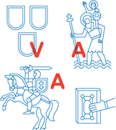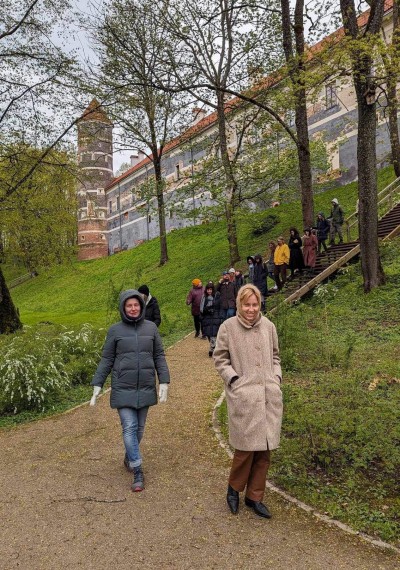Life in the Folds.
Baroque Tensions, Affects and Movements
One-day Seminar in Vilnius, April 25, 2024
Location: Sapieha Palace, Vilnius
Organizers: Vilnius Academy of Arts, Department of Doctoral Studies, Department of Art History and Theory University of Copenhagen, PASS – Centre for Practice-based Art Studies
In collaboration with: Vilnius Academy of Arts, Department of Sculpture, Sapieha Palace, branch of the Contemporary Art Centre, Vilnius
The term baroque has had many meanings and applications over time. It emerged in the 18th century to describe the so-called bizarreries and moral decay in architecture and painting of the period and the previous century. Later, it came to refer to those aspects of 17th century art that were characterized by dynamic composition, dramatic use of contrasts and a certain raw naturalism. In the 20th century, Baroque and New World Baroque has been used to describe various trends in European and Latin American modernism and popular culture characterized by textural richness, emotional impact, and movement. What do we mean by and how do we fathom the baroque today?
In this seminar, we will explore the Baroque both as a historical epoch filled with political tensions, expansive capitalism, the centralized power of absolutism and dramatically changed living conditions for ordinary people, and as a transhistorical and transcultural way of organizing matter dynamically and sometimes defiantly that can manifest itself at different locations, including in contemporary art and culture. The seminar will discuss the Baroque in both, often intertwined, respects: as historical and as contemporary. On the one hand, the baroque was a historical era when war and strife over religious and territorial issues ravaged Europe, and when climate change and increasing demand for new luxury goods led to the colonization of overseas peoples and territories - with disastrous and long-lasting consequences that still shape our world and ways of thinking. It was also a time of rapid change and wild experimentation in art, philosophy and science. On the other hand, the historic Baroque period spawned new ways of thinking about the relationshipbetween form, affect and matter that continue to preoccupy historians, artists and scientists. 20th century philosophers and artists such as Walter Benjamin, Gilbert Simondon, Gilles Deleuze, Henri Michaux, Alejo Carpentier, Édouard Glissant and Christine Buci-Glucksman have contributed to rethinking the Baroque from both a historical and contemporary perspective. The seminar ,,Life in the Folds. Baroque Tensions, Affects, and Movements" invites you to reflect on both the historical legacy of the Baroque as well as the challenges it poses and the possibilities it offers to us today.
Please find detailed program of the seminar below
9.30-9.40 Coffee and welcome word
dr. Julija Fomina, director of PhD Studies in Art History and Theory, Vilnius Academy of Arts
9.40-9.55 Introduction to the seminar
Mikkel Bogh, Professor of Art History, Director of Center for Practice-based Art Studies, University of Copenhagen
9:55-10:10 Opening remarks and short introduction to Sapieha Palace
dr. Gintautė Žemaitytė, Executive director, Sapieha Palace
10.10-10.40 Introduction to the history of Sapieha Palace
Laura Misiūnaitė, Head of cultural education, Sapieha Palace
10.40-11.20 Internationality of Baroque: Four Cases of Artworks in the Church of the Holy Spirit in Vilnius
Birutė Valečkaitė, PhD fellow in Art History and Theory, Vilnius Academy of Arts
11.20-12.00 Between Fight and Fun in 17 th Century Denmark: The Peculiar Case of King Frederik III’s Wet Trap Chair
Casper Thorhauge Briggs-Mønsted, PhD fellow, Dept. of Arts and Cultural Studies, University of Copenhagen
12.00-12.40 Disruptive Travelling: Subversions of Power and Poetic Relations in Baroque Images between Europe and the Americas
Mikkel Bogh, Professor of Art History, Director of Center for Practice-based Art Studies, University of Copenhagen
12.40-13.40 Lunch
13.40-14.20 Guided tour in the exhibition Refuge Virginija Januškevičiūtė, Edgaras Gerasimovičius PhD fellows in Art History and Theory, Vilnius Academy of Arts
14.20-15.00 Inflection, Field, and Singularity: Towards a Concept of Form in Contemporary Art Practice through Gilbert Simondon, Gilles Deleuze, and Henri Bergson
Henrik B. Andersen, Professor, Dept. of Sculpture, Vilnius Academy of Arts
15.00-15.40 “By means of Rome”: The Baroque as Lesson and Resource in Robert Venturi’s Oeuvre
Kasper Lægring, New Carlsberg Foundation Postdoctoral Fellow in Art History, Aarhus University
Coffee break
16.00-16:45 Baroque folds and afterlives: а Roundtable discussion w. speakers and audience, chaired by Mikkel Bogh
Internationality of Baroque: Four Cases of Artworks in the Church of the Holy Spirit in Vilnius
Birutė Valečkaitė, PhD fellow, Vilnius Academy of Arts
This presentation is based on the author’s recent discoveries of prints of engravings that became examples for several artworks created during the Baroque restoration of the Church of the Holy Spirit in Vilnius in 1750–1770. One of the frescoes, The Vision of St Dominic, the stucco moulding St Dominic, as well as paintings from the altars of St Hyacinth and of Our Lady of the Rosary, were all based on works by famous artists from Antwerp, Augsburg, Rome, and Palermo. Similar engravings were often commissioned by the artists themselves in order to ensure the dissemination of their works. They were easily transported and often copied in Lithuania and other countries.
Through cases of these examples, it is possible to talk about the international ‘journeys’ of images, their distinctive interpretations in Vilnius and the mentality of the Baroque population, which is evident in the choice of the primary images and their placement in the late Baroque space of the rebuilt Church of the Holy Spirit.
Between Fight and Fun in 17 th Century Denmark: The Peculiar Case of King Frederik III’s Wet Trap Chair
Casper Thorhauge Briggs-Mønsted, PhD fellow, Dept. of Arts and Cultural Studies, University of Copenhagen
I take as my starting point a chair from the time of Danish King Frederik III, which is designed to trap the unsuspecting person who sits in it and to empty water into their lap. A colleague and I are currently researching the chair to learn more about its history, and with that in mind, I will introduce it and place it in the context of a wider European court entertainment culture that seems to have always existed somewhere between carefree pleasure and the ever-present threat of future war or the memory of what happened in the past. I suggest that this duality is particularly characteristic of baroque celebrations – two contradictions folded into one another.
Disruptive Travelling: Subversions of Power and Poetic Relations in Baroque Images between Europe and the Americas
Mikkel Bogh, Professor of Art History, Director of Center for Practice-based Art Studies, University of Copenhagen
In this presentation I aim to discuss the transformative journeys of a baroque aesthetic, spanning from its origins in Europe to its impact in the Americas. It explores how the baroque's dynamic and affective qualities not only facilitated the exercise of political, religious, and cultural power in the 17th century but also enabled its evolution into a fluid and subversive force. The paper examines how baroque imagery, initially aligned with counter-reformational agendas, later began to antagonise colonial and other power formations it had been inextricably linked to. By analyzing neo-baroque tendencies in contemporary art, it demonstrates how the baroque aesthetic ‘travels’ across geographical and temporal boundaries, adapting to diverse cultural contexts while maintaining its disruptive potential and giving rise to new poetic relations.
Inflection, Field, and Singularity: Towards a Concept of Form in Contemporary Art Practice through Gilbert Simondon, Gilles Deleuze, and Henri Bergson
Henrik B. Andersen, Professor, Dept. of Sculpture, Vilnius Academy of Arts:
This paper, inspired by Deleuze’s book "The Fold. Leibniz and the Baroque" (1993), discusses a concept of form in the philosophies of Gilbert Simondon, Gilles Deleuze, and Henri Bergson, in the context of contemporary art practice. Andersen's inquiry presents the notions of inflection, field, and singularity as foundational elements that define certain contemporary artistic explorations and processes.
“By means of Rome”: The Baroque as Lesson and Resource in Robert Venturi’s Oeuvre
Kasper Lægring, New Carlsberg Foundation Postdoctoral Fellow in Art History, Aarhus University:
When architect Robert Venturi published his “gentle manifesto” Complexity and Contradiction in Architecture in 1966, it not only signalled a critical challenge to the architectural praxis of modernism but also represented an unorthodox and creative view of the legacy of the Baroque. This paper will explore both familiar and overlooked aspects of Venturi’s seminal book, whose mission has not always been fully understood. Hence, despite Venturi’s inspiration from Gestalt psychology, Rudolf Arnheim heavily criticized the book. The paper will focus on Venturi’s understanding of Mannerism and the Baroque as a resource available to the architect, whose ambiguity carries a sense of modernity that transcends attempts at stylistic characterization. An altered and more complex role of the viewer is crucial here.







